
- Afhalen na 1 uur in een winkel met voorraad
- Gratis thuislevering in België vanaf € 30
- Ruim aanbod met 7 miljoen producten
- Afhalen na 1 uur in een winkel met voorraad
- Gratis thuislevering in België vanaf € 30
- Ruim aanbod met 7 miljoen producten
Zoeken
Shamans/Neo-Shamans
Ecstasies, Alternative Archaeologies and Contemporary Pagans
Robert J Wallis
Hardcover | Engels
€ 290,45
+ 580 punten
Uitvoering
Omschrijving
In popular culture, such diverse characters as occultist Aleister Crowley, Doors musician Jim Morrison, and performance artist Joseph Beuys have been called shamans. In anthropology, on the other hand, shamanism has associations with sorcery, witchcraft and healing, and archaeologists have suggested the meaning of prehistoric cave art lies with shamans and altered consciousness. Robert J. Wallis explores the interface between 'new' and prehistoric shamans. The book draws on interviews with a variety of practitioners, particularly contemporary pagans in Britain and north America. Wallis looks at historical and archaeological sources to explore contemporary pagan engagements with prehistoric sacred sites such as Stonehenge and Avebury, and discusses the controversial use by neo-Shamans of indigenous (particularly native American) shamanism.
Specificaties
Betrokkenen
- Auteur(s):
- Uitgeverij:
Inhoud
- Aantal bladzijden:
- 336
- Taal:
- Engels
Eigenschappen
- Productcode (EAN):
- 9780415302029
- Verschijningsdatum:
- 20/02/2003
- Uitvoering:
- Hardcover
- Formaat:
- Genaaid
- Afmetingen:
- 172 mm x 227 mm
- Gewicht:
- 671 g

Alleen bij Standaard Boekhandel
+ 580 punten op je klantenkaart van Standaard Boekhandel
Beoordelingen
We publiceren alleen reviews die voldoen aan de voorwaarden voor reviews. Bekijk onze voorwaarden voor reviews.








